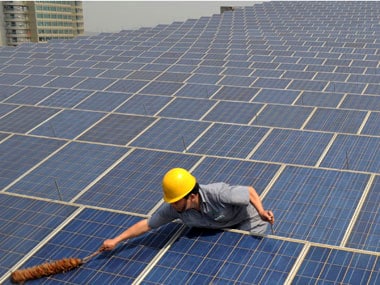New Delhi: The government today raised the solar power generation capacity addition target by five times to 1,00,000 MW by 2022, which will entail an investment of around Rs 6 lakh crore.[caption id=“attachment_2280070” align=“alignleft” width=“380”]  Representational image. [/caption] “Union Cabinet chaired by Prime Minister Narendra Modi, today gave its approval for stepping up of India’s solar power capacity target under Jawaharlal Nehru National Solar Mission (JNNSM) by five times, reaching 1,00,000 MW by 2022,” an official release said. “The cabinet decision is a giant step towards creating clean and sustainable energy source in the country,” Communication and IT Minister Ravi Shankar Prasad told reporters after the cabinet meeting. According to the statement, the target will principally comprise of 40 GW (solar) rooftop and 60 GW through large and medium scale grid connected solar power projects. Wth this ambitious target, India will become one of the world’s largest green energy producers, surpassing several developed countries, it added. “The total investment in setting up 100 GW will be around Rs 6,00,000 crore. In the first phase, the Government of India is providing Rs 15,050 crore as capital subsidy to promote solar capacity addition in the country,” it said. This capital subsidy will be provided for rooftop solar projects in various cities and towns, for Viability Gap Funding (VGF) based projects to be developed through the Solar Energy Corporation of India (SECI) and for decentralised generation through small solar projects. The release said that solar power projects with investment of about Rs 90,000 crore would also be developed using bundling mechanism with thermal power. Further investment will come from large public sector undertakings and independent power producers. State governments have also come out with state specific solar policies to promote solar capacity addition. Meanwhile, the Cabinet Committee on Economic Affairs approved setting up of over 2,000 MW of grid-connected solar PV power projects on build, own and operate basis by solar power developers with viability gap funding under Batch-III of Phase-II of the JNNSM. This would help in generating 12,000 jobs in rural and urban areas and reduction of about 3.41 million tonnes of CO2 emissions into the environment every year. The total investments expected under this scheme is about Rs 12,000 crore. The estimated requirement of funds to provide VGF for 2,000 MW capacity solar projects is estimated to be Rs 2,100 crore (Rs 1 crore/MW for open category and Rs 1.31 crore /MW for domestic content requirement category). The new solar target of 100 GW is expected to abate over 170 million tonnes of CO2 over its life cycle, the release said, adding this solar scale-up plan has a target of 40 GW through decentralised solar power generation in the form of grid connected rooftop projects. While decentralised generation will stabilise the grid, it will minimise investment on power evacuation. “Government may also approach bilateral and international donors as also Green Climate Fund for achieving this target. Solar power can contribute to long term energy security of India and reduce dependence on fossil fuels that put a strain on foreign reserves and the ecology as well,” it said. The solar manufacturing sector will get a boost with this long term trajectory of solar capacity addition. This will help in creation of technology hubs for manufacturing. The increased manufacturing capacity and installation are expected to pave way for direct and indirect employment opportunities in both the skilled and unskilled sector. The release said that VGF scheme will be implemented for setting up over 2000 MW capacity of grid connected solar power projects by solar power developers on Build, Own and Operate (BOT) basis through open and transparent competitive bidding. The solar power would be provided at a pre-defined tariff of Rs 5.43 per kWh for the first year, with escalation of 5 paisa per kWh each year till the tariff reaches the level of Rs 6.43 per kWh. This would take 21 years and tariff, thereafter, would remain fixed at Rs 6.43 per kWh. The levelised tariff would be Rs 5.79 per kWh. The overall effort is to continuously reduce government financial support for grid connected solar power as the prices of solar power comes down, it said. The scheme will be implemented by SECI as per Ministry of New and Renewable Energy (MNRE) Guidelines. SECI shall prepare necessary bidding documents for inviting proposals for setting up of projects on a competitive bidding through e-bidding. PTI
The release said that solar power projects with investment of about Rs 90,000 crore would also be developed using bundling mechanism with thermal power.
Advertisement
End of Article
Written by FP Archives
see more


)

)
)
)
)
)
)
)
)



